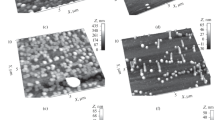Abstract
Triboelectrization as a result of the scanning of an atomic-force-microscope probe over an n-GaAs surface in the contact mode is investigated. The dependences of the local potential variation on the scanning rate and the pressing force of the probe are obtained. The results are explained by point-defect formation in the surface layers of samples under the effect of deformation of these layers during probe scanning. The charge localized at these defects in the case of equilibrium changes the potential of surface, which is subject to triboelectrization. It is shown that, for qualitative explanation of the observed dependences, it is necessary to take into account both the generation and annihilation of defects in the region experiencing deformation.
Similar content being viewed by others
References
B. Bhushan, Principles and Applications of Tribology, 2nd ed. (Wiley, Chichester, 2013) p. 980.
Nanotribology and Nanomechanics: Measurement Techniques and Nanomechanics, Ed. by B. Bhushan (Springer, Berlin, Heidelberg, 2011), Vol. 1, p. 623.
Nanotribology and Nanomechanics: Nanotribology, Biomimetics and Industrial Applications, Ed. by B. Bhushan (Springer, Berlin, Heidelberg, 2011), Vol. 2, p. 1017.
B. Bhushan and A. V. Goldadem, Wear 244, 104 (2000).
M. Chiesa and R. Garcia, Appl. Phys. Lett. 96, 263112 (2010).
Hao Sun, Haibin Chu, Jinyong Wang, Lei Ding, and Yan Li, Appl. Phys. Lett. 96, 083112 (2010).
D. J. Lacks and R. M. Sankaran, J. Phys. D: Appl. Phys. 44, 453001 (2011).
M. Mirkowska, M. Kratzer, C. Teichert, and H. Flachberger, Chem. Ing. Tech. 86, 857 (2014).
Y. Martin, D. W. Abraham, and H. K. Wickramasinghe, Appl. Phys. Lett. 52, 1103 (1988).
M. Nonnenmacher, M. P. O’Boyle, and H. K. Wickramasinghe, Appl. Phys. Lett. 58, 2921 (1991).
P. N. Brunkov, V. V. Goncharov, M. E. Rudinskii, A. A. Gutkin, N. Yu. Gordeev, V. M. Lantratov, N. A. Kalyuzhnyi, S. A. Mintairov, R. V. Sokolov, and S. G. Konnikov, Semiconductors 47, 1170 (2013).
J. L. Hutter and J. Bechhoefer, Rev. Sci. Instrum. 64, 1868 (1993).
I. Szlufarska, M. Chandross, and R. W. Carpick, J. Phys. D: Appl. Phys. 41, 123001 (2008).
A. I. Livshits and A. L. Shluger, Phys. Rev. B 56, 12482 (1997).
U. Landman, W. D. Luetke, and M. W. Ribarski, J. Vacuum. Sci. Technol. A 7, 2829 (1989).
U. Landman, W. D. Luetke, and E. M. Ringer, Wear 153, 3 (1992).
H. Bracht, M. Norseng, E. E. Haller, K. Eberl, and M. Cardona, Solid State Commun. 112, 301 (1999).
G. A. Baraff and M. Schlüter, Phys. Rev. Lett. 55, 1327 (1985).
E. W. Williams and H. B. Bebb, in Semiconductors and Semimetals, Ed. by R. K. Willardson and A. C. Beer (Academic Press, New York, London, 1972), Vol. 8, p. 321.
P. Krispin, J. Appl. Phys. 65, 3470 (1989).
T. Ishida, K. Maeda, and S. Takeuchi, Appl. Phys. 21, 257 (1980).
Author information
Authors and Affiliations
Corresponding author
Additional information
Original Russian Text © A.V. Baklanov, A.A. Gutkin, N.A. Kalyuzhnyy, P.N. Brunkov, 2015, published in Fizika i Tekhnika Poluprovodnikov, 2015, Vol. 49, No. 8, pp. 1083–1087.
Rights and permissions
About this article
Cite this article
Baklanov, A.V., Gutkin, A.A., Kalyuzhnyy, N.A. et al. Effect of the interaction conditions of the probe of an atomic-force microscope with the n-GaAs surface on the triboelectrization phenomenon. Semiconductors 49, 1057–1061 (2015). https://doi.org/10.1134/S1063782615080060
Received:
Accepted:
Published:
Issue Date:
DOI: https://doi.org/10.1134/S1063782615080060



